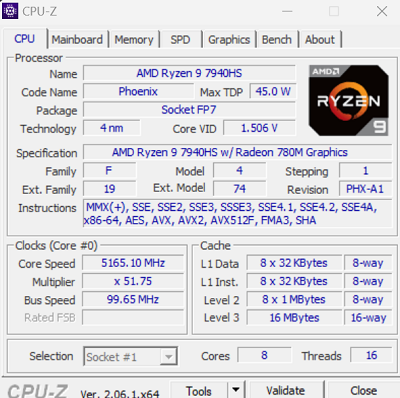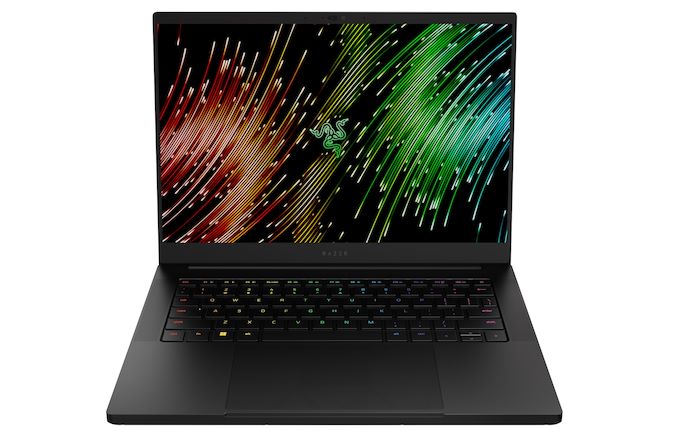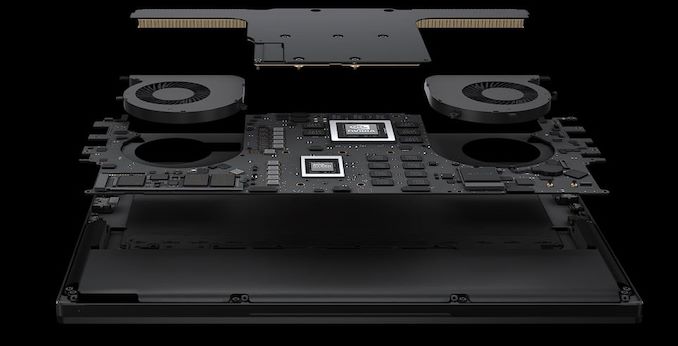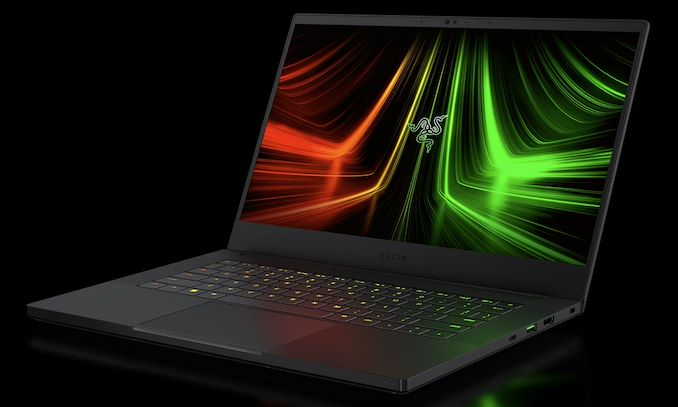The Razer Blade 14 (2023) Laptop Review: Ryzen 9 7940HS Tested With GeForce RTX 4070 Graphics
by Gavin Bonshor on June 20, 2023 11:00 AM ESTConclusion
The last time we looked at a Razer Blade was back in 2021; believe it or not, not much has changed in the overall styling and presentation of Razer's bespoke gaming notebook range. A common mantra that reigns true is, if something isn't broken, don't fix it, and the Razer Blade 14 is a timeless example of a notebook series that rests on its laurels with a premium design, quality construction, and varied levels of performance.
Compared to last year's Razer Blade 14 powered by AMD's Zen 3 Ryzen 9 6900HX, this year's model features the highly anticipated Zen 4 mobile chip from the Ryzen 7040HS series. At launch, all the Razer Blade 14's with Ryzen 7040HS processors all feature the flagship 8C/16T model, the Ryzen 9 7940HS, which in itself, compared to the Ryzen 9 6900HX, is a successor, although not a direct comparison as the HX series IS the flagship AMD mobile series. At the same time, the 7040HS offers more on paper than the previous Ryzen 6000HX series.
On the specifications of the CPU within the Blade 14 (2023), it has a base clock of 4.0 GHz and a 1T boost clock of up to 5.2 GHz, which is fast, and all within a 54 W TDP, which in our power tests, operates bang on the money. Based on TSMC's improved 4 nm process, the Zen 4 cores within the Ryzen 9 7940HS certainly offer a solid level of compute performance, as we found in our testing, and it's clear that Zen 4's efficiency and performance both suit a mobile notebook such as the Blade 14.
As with any product from Razer, the focus is always on gaming, and pushing the framerates within the Blade 14 is NVIDIA's RTX 4070 Laptop graphics card. Limited to a total graphics power of 140 W, there's adequate power to drive the impressive and crisp 14" 2560 x 1600p 240 Hz high-spec IPS panel. Despite being limited to just 8 GB of GDDR6 VRAM, the RTX 4070 isn't going to sell a gaming notebook itself. Still, with a very high 240 Hz refresh rate, most of the advantages here will come in eSports titles such as CS: GO, League of Legends, and Valorant.
As we found in our testing, running high-end games at high settings at the Blade 14's native 1600p (16:10), resolution is still very playable, albeit between the 60 and 100 fps mark. Possible benefits include utilizing AMD's Radeon 780M and super-resolution (FSR) and dropping the resolution to 1200p. Still, having solid playable frame rates on a gaming notebook with such a small 310.7 x 228 x 117.99 mm ( W x H x D) sized notebook is still mightily impressive, and the overall build quality from Razer's custom CNC milled aluminum chassis is something else.

Included within the Blade 14 is a 68.1 Wh battery, which is more than ample for a typical notebook. Still, for a notebook designed primarily around gaming, a bigger battery for gamers is ideal, and without a power outlet close by, users aren't going to get much time at all. In our real-world gaming testing, we got 79 minutes of game time in F1 2022 at 50% brightness, which is good for ANY gaming notebook.
Using the UL Procyon test suite's battery life tests, we got modest results of 154 minutes of video playback time at 50% brightness but a much better battery life of 450 minutes on the integrated Radeon 780M. The drivers and software SHOULD pick up on the application being used at the time, and if a game is selected, the Blade 14 will select the graphics providing GPU mode is switched to automatic. In the office-based section of the UL Procyon battery life benchmark, we managed to get 430 minutes of runtime before the battery depleted. The charge time of the Razer Blade 14 is, however, very impressive, with a 0% to 100% charge time of just 99 minutes.
Razer's liquid-vapor filled chamber cooling design
On the design front, the Razer Blade 14 is a serious no-compromise notebook in style, construction, thermal capabilities, and features. Per key RGB customization is an excellent thing to have for users looking to add a bit of flair, while Razer's Synapse software and overall ecosystem are industry-leading. We didn't experience any thermal throttling of the CPU or the GPU in our testing, and the chassis itself didn't get too warm, which shows the quality of Razer's patented complete vapor chamber cooling design. Touching briefly on the audio quality from the dual front-firing speakers, they certainly offer better audible sound quality than cheaper notebooks. Still, as with any notebook speaker setup, they do have limitations at max volume, but they do sound good, even with different varieties of music, gaming, and when watching a movie (I watched Creed III over the weekend and the experience was good).
Now onto the pricing, and the Razer Blade 14 (2023) with AMD's Ryzen 9 7940HS and NVIDIA GeForce RTX 4070 options aren't cheap. The thing with the Razer Blade, in general, is Razer focuses a lot on the overall design and user experience and provides solid levels of performance throughout the Blade series. The Razer Blade 14 sample we received has 16 GB of DDR5-5600 memory, and a fast 1 TB PCIe 4.0 x4 storage drive, which are high-end parts, and deliver the required performance levels.

CPU-Z screenshot of the AMD Ryzen 9 7940HS processor
This particular Blade 14 has a price tag of $2700, which is certainly something to be desired, and there are similar combinations with similar specifications available from other brands at a lower price. Prices start at $2400 for the Blade 14 with slightly lower spec RTX 4060 graphics, with both models available in a matte black anodized aluminum finish. The most expensive of the Blade 14's with the Ryzen 9 7940HS has a whopping price tag of $2800, but it does have the Ryzen 9 7940HS, RTX 4070, but with 32 GB of DDR5-5600 memory, and comes in a very sleek looking mercury white finish.
As always, with price, it's a subjective matter of what a person is willing to pay. Still, given the Razer Blade 14's striking and premium design, the impressive vapor chamber cooling solution integrated within, and the performance on offer, the Razer Blade 14 is a very premium gaming notebook. The Razer Blade 14 notebooks are perhaps some of the most premium notebooks on the market, and nothing about it is cheap, but that's what Razer is good at with its notebooks and products; premium quality, premium performance, but with a premium price tag.
Overall the Razer Blade 14, powered by the latest Ryzen 9 7940HS processor, is a quality notebook with solid levels of performance and adequate battery life, and it has enough style and substance to make it a worthwhile purchase. The Ryzen 9 7940HS (8C/16T) itself is very comparable performance-wise with the desktop Zen 4 chips, the Ryzen 7 7700 (8C/16T), and Ryzen 5 7600 (6C/12T), and it is clear that Zen 4 in the notebook space showcases AMD's incredible power and performance efficiency. The Razer Blade 14 is the ideal showcase for this.













32 Comments
View All Comments
yannigr2 - Tuesday, June 20, 2023 - link
What the hell is this?Sorry for this way of starting, but what the hell is this? A laptop review where we see comparisons, not with other laptops but desktop CPUs and what the hell is this battery test? I am no expert in laptops but when from 500nits to 250nits difference, we only get 5 extra minutes, probably the review is withhold until Razer replies. When Razer says 9 hours and the result is no more than 2 and a half hours, withholding the review until Razer replies also makes more sense than publishing the review immediately and finding out latter. This is Anandtech. Quality is more important than speed or quantity. At least that's how we see Anandtech people who started reading it more than 20 years ago.
meacupla - Tuesday, June 20, 2023 - link
If I had to guess, the GPU is permanently on or the benchmark is flawed and not using hardware decode from the CPU.I've seen better battery life results from a 10500H with a 54Whr battery while playing back youtube over wifi.
Gavin Bonshor - Tuesday, June 20, 2023 - link
Yeah I'm currently looking into the battery life testing. It's currently on test as we speak. Apologies for thatyannigr2 - Wednesday, June 21, 2023 - link
Had a quick look at other sites after posting here. They report from 6+ hours to over 8+ hours of battery time, relative to how they test battery time. When something looks wrong, have a quick check on other sites, contact the company first then post a review.Anyway, ....
brandonicus - Tuesday, June 20, 2023 - link
That's a good initial question.I've been shopping around for laptops lately, and this is the most unhelpful review I have seen. They included almost no comparisons, and as you mentioned the comparisons they did include are extremely poor choices.
I haven't been on Anandtech in forever and it was definitely weird seeing a review like this... if you don't have all the data just don't put out the review.
ballsystemlord - Tuesday, June 20, 2023 - link
I have to go along with you guys, having nothing to compare to makes this review rather worthless.Hopefully, they'll benchmark more laptops and we'll get some decent comparisons.
temps - Thursday, June 22, 2023 - link
I wouldn't hold my breath for more reviews. They basically don't do anything anymore ... they have cut down so massively on hardware reviews they no longer have a good basis of comparison for anything because they have no data points built up. The Bench is a dated wasteland. They haven't done GPU reviews in almost 4 years. The only thing you can reliably depend on them to cover is new CPU releases.. anything else? Forget itHulk - Tuesday, June 20, 2023 - link
I agree except that I do like having one desktop processor in the benchmarks as I'm more familiar with those results so it's nice to have a reference point.yannigr2 - Wednesday, June 21, 2023 - link
One desktop CPU, yes I agree with you. But with half a dozen laptops next to that CPU.PeachNCream - Tuesday, June 20, 2023 - link
It's a start perhaps. This is the first time I've seen AT benchmark something other than a PSU or removable drive in ages (an exaggeration, but you get the point) so they don't exactly have a large dataset to draw from. I'd say encouragement is a better idea than criticism since maybe, just maybe, Anandtech will get back to doing more than sharing press releases from faceless companies we don't care about.